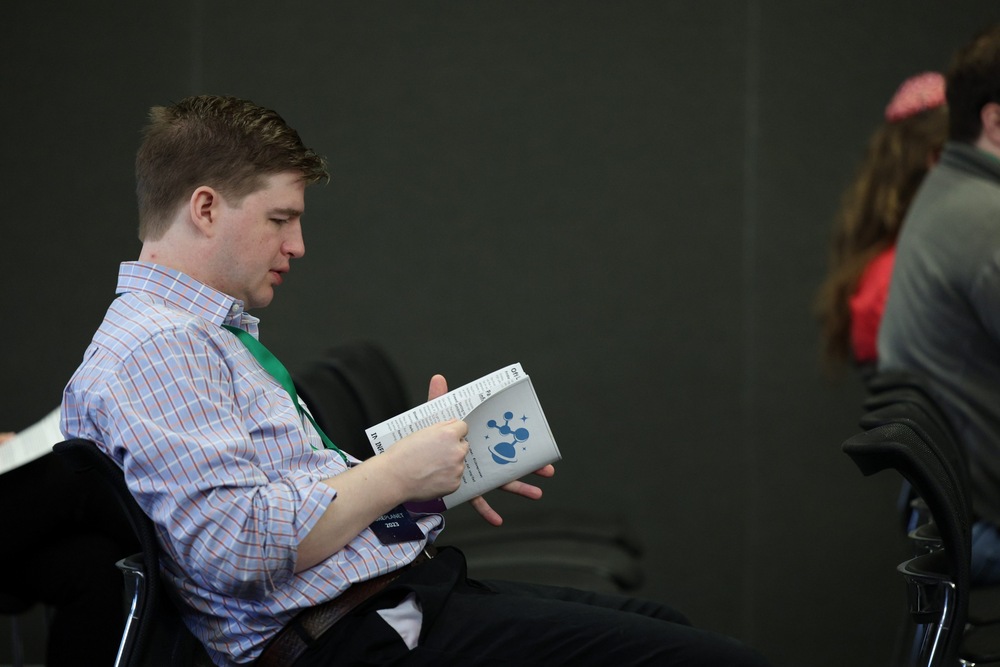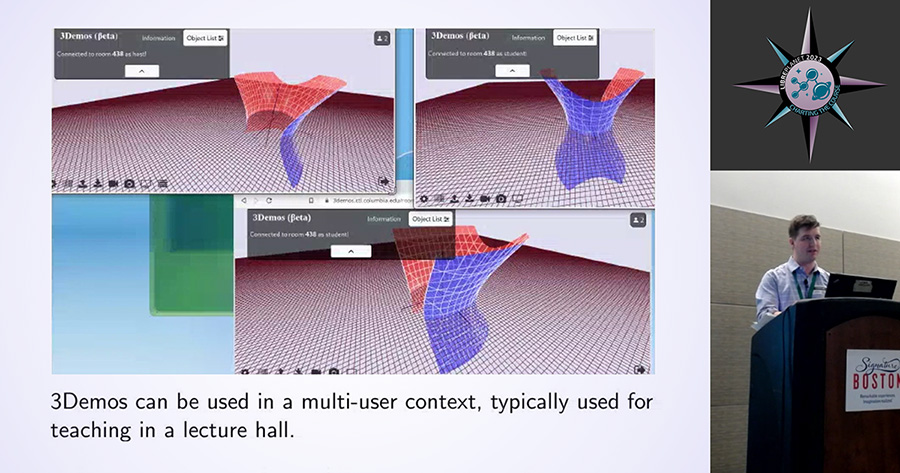I want to summarize the LibrePlanet 2023 conference and also share some thoughts on how the ideas of the free software movement relate to ed-tech in higher education. LibrePlanet is the Free Software Foundation’s annual March conference in Boston.
As the conference began, I presented on a recent project, 3Demos. In this project, the CTL partnered with Drew Youngren, Columbia Univeristy Lecturer in the Discipline of Applied Mathematics, to create a collaborative tool for illustrating multi-variable calculus concepts.

CTL developer Nik Nyby presented on 3Demos at the LibrePlanet conference.
— Source: Red Shade Studios for LibrePlanet: Charting the Course.
Educator and researcher Erin Rose Glass gave a keynote talk titled “Education and the future of software freedom”. She presented the current world of ed-tech, whether it’s a learning management system or a plagiarism detection tool, as a vast, opaque surveillance apparatus. These technologies are unfortunately standard in the world of higher education, and students aren’t always given much choice on how they interact with these tools.
In contrast, Glass also touched on her experience with efforts like the CUNY Academic Commons, that show the fun, creative side of educational technology. As Glass noted, and I mentioned in my talk, there are endless possibilities for digital technology in education. We can think wider than just what the ed-tech industry provides: through close partnership with faculty and institutions, we’re able to create things that aren’t possible elsewhere. Just think: what new possibilities haven’t been uncovered yet?
You can read Erin Rose Glass’s blog post tying the topics of her keynote to other ethical dilemmas in software supply chain security: Dystopian edtech and the future of software supply chain security
The CTL also worked with Thomas Groll, Senior Lecturer in the Discipline of International and Public Affairs, to develop EconPractice. EconPractice is an example of how free/open source software provides value and flexibility for a learning tool. Early iterations of these interactive economics graphs were built out using proprietary tools provided by a large ed-tech company called Smart Sparrow. While these tools made it possible to put the initial stages of this project together, its technical functionality had hard limits that couldn’t be overcome by Smart Sparrow’s development model. It also required significant licensing costs on the part of both instructor and student in order to access this technology.
Through our partnership with Groll, we’ve put together custom graphs using another open source project JSXGraph. Our use of JSXGraph led us to participate in the JSXGraph conference last fall, through which we’ve made new connections with the wider community of economists and technologists using tools like this to teach in the classroom. None of this would’ve been possible if EconPractice was still built on top of Smart Sparrow.
Of course, custom-built, bespoke and sustainable free software isn’t always viable. The CTL is fortunate to have the resources to build and maintain our projects for years. Although only a small percentage of prospective projects get approved for funding, our vast portfolio grows steadily. In addition to the significant effort it takes to put together a project like this, any software needs development expertise to keep it working as platform technology changes over time.
When you don’t have the resources and expertise of a CTL to support the development of an idea, a service like Smart Sparrow can make a lot of sense. I suppose it’s my hope that ed-tech companies are able to embrace the open nature of the web so that their technology remains accessible to the widest range of people. Moreover, they must think larger than themselves, and consider how their technology can remain useful in situations where their company changes, or is no longer around.
We have also seen that a framework like H5P can be a more reliable alternative to easily create the sort of interactivity that something like Smart Sparrow provides, without requiring real development work.
As we design technology for classroom use, it’s important to look deeply at the technology involved at all its various layers. For example, why do we even have this thing called “the web” that we make learning tools with? The nature of academia lends itself easily to the hands-on, open principles of free software. Indeed, hacker culture prides itself on fostering the natural collaboration that occurs in the practice of teaching and learning.
Similarly, from a student’s perspective, what tools will I use to take me through my academic career, and how can I ensure that I will always have access to the digital artifacts I create, as technology changes under our feet? Columbia faculty Dennis Tenen delves deeper into these questions in his book, Plain Text: The Poetics of Computation.
Here are a few more highlights I’ve noted from the conference. As LibrePlanet always has multiple talks going on at once, I unfortunately wasn’t able to capture everything.
- An Australian hacker who calls himself Sick Codes spoke about The state of free software in farming, food agriculture. Specifically, he exposed the dilemmas confronted by farmers who own John Deere tractors, and their now-precarious right to repair and manage their investments, and in many cases their livelihood.
- Dr. William Cooper Davidon, an engineer at the Federal Aviation Administration, spoke about software safety in airlines and their surrounding federal regulations. Safety-critical software certification and why free software
The conference concluded with an inspiring keynote from Dr. Elizabeth Chamberlain from iFixit on the future of the right to repair and free software.
Printed from: https://compiled.ctl.columbia.edu/articles/libreplanet-2023-recap/

